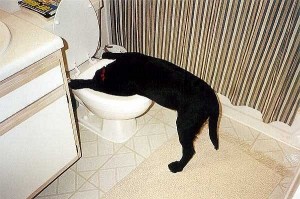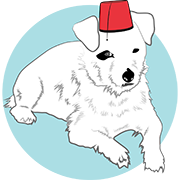
This week’s Friday Focus question is: What are the best methods of calming your dog during a car trip?
It’s not just Frankie who’s afflicted with car stress. Images of carefree dogs jumping joyously into cars notwithstanding, lots of dogs shake, drool, whine, and otherwise evince signs of misery as soon as they hear the sound of a car ignition key turning.
This behavior, frankly, drives owners crazy, and not only because we can’t stand to see our dogs suffer, which we can’t. It’s also because, aside from the occasional vet visit, we know we’re just trying to give our dogs a good time at the park, beach, dog-friendly restaurant….
Why won’t they understand that?
And then there’s the added annoyance of telling another dog owner about your pup’s car issues only to have her say: “I can’t imagine that. My dog just LOVES car rides!” Way to make you feel like you’re living with a mutant.
Well, you’re not. Their dogs are mutants. Dogs were not designed to ride in automobiles.
Neither were humans. Which brings me to the point of this post. Automobile anxiety may stem from physical discomfort, a.k.a. motion sickness. Your dog gets in the car, feels sick, and doesn’t want to get in the car again.
Which dogs get it and why?
According to WebMD:
Dog motion sickness is more commonly seen in puppies and young dogs than in older dogs, just as carsickness afflicts more children than adults. The reason for this is because the ear structures used for balance aren’t fully developed in puppies. This isn’t to say that all dogs will outgrow travel sickness, though many will.
Or as MyDogInfo puts it:
Receptors in the ear called the vestibular apparatus help an animal process position and movements. These movement signals are relayed by the 8th cranial nerve to the brain, including the CRTZ (chemoreceptor trigger zone). The CRTZ is one of the zones in the brain that controls the vomiting reflex by input of signals to the lateral reticular formation vomiting centre. The dog will experience motion sickness if the signals coming in are excessive.
Who knew there was a vomiting centre?
Symptoms
As you might expect — now that you know there is a vomiting centre — the most obvious symptom of motion-induced discomfort is food-chucking. But the vigilant may be able to prevent gracing the car with dog puke by observing such precursor signs as salivation, yawning, panting, and pacing (assuming your dog has room to pace, in which case she isn’t secured very well. But that’s another topic), and getting your dog out of the car before it’s too late.
Of course, some dogs will throw up immediately, in which case you’re SOL.
Prevention
Many dogs outgrow motion-induced car sickness, but in the meantime:
- Don’t let your dog eat within an hour of the ride — or, if an empty stomach seems stressful, let him eat only a little bit. Or, according to DogChannel.com:
Bulky, greasy meals may help cause motion sickness. The best advice is to feed light (low in proteins and fats and high in carbohydrates) meals or snacks that are low in total calories in the 24 hours before traveling. Interestingly, low intake levels of vitamins A and C and iron are associated with increased incidence of motion sickness in people – perhaps another reason to add some A, C, and iron to your dog’s diet.
- Open the window a bit to allow fresh air in.
- If — and only if — you’ve disabled the air bag in the front seat, let your dog ride up front where there’s less motion. It goes without saying — but I’ll say it anyway — that your dog should either be belted in or in a secured crate.
- Seeing things fleeting by on the side disturbs some dogs. If your dog is large enough to see outside from a crate, consider getting a crate with solid sides or draping something over both sides so he can only look straight ahead.
- Some dogs are okay for short periods before feeling sick. Monitor the signs carefully and stop the car and let your dog take a short walk before proceeding again.
Medications
For long trips, there’s also medication, natural or traditional, to consider. For some reason, nothing I read suggested giving your dog lots of Saltine crackers.
- Herbal remedies. From DogChannel.com again:
There are several herbs that have been used for upset stomach and for motion sickness particularly, but the best known and perhaps most effective is ginger, Zingiber officinale. Ginger has a long history of medicinal use in traditional Chinese medicine and Ayurvedic (Indian) medicine. Research has shown it to be effective in relieving symptoms of nausea, vomiting, indigestion, flatulence, and dizziness. Ginger works mainly in the digestive tract, where it boosts digestive fluids and neutralizes acids.
Other herbs that help to calm the stomach include peppermint (Mentha piperita), chamomile (Anthemis nobile or Matricaria chamomilla), horehound (Ballota nigra), and the Chinese herb Pingandan, a mixture of several herbs.
- Conventional medicine. Anti-emetics designed specifically for motion sickness such as Dramamine are often suggested by vets. Always check first to see what’s okay for your dog, and at what dosage.
As noted, some dogs outgrow motion sickness and thus car anxiety. But some dogs continue to associate car rides with feeling queasy, even if they no longer have symptoms. My next posts will cover other ways to deal with car stress — and you won’t even have to wait until next Friday. Stay tuned.

Our first Shar-Pei got car sick. Benadryl lessened the symptoms. Ty, has absolutely no issues being in the car (a mutant, as you say). He will just curl up in his bed and sleep the whole time, happy to be driving to our destination and not to be walking!!
The weird thing with Buster is that he loves the car/RV. Before we started traveling, he would HANG OUT in the car while we did outside chores. HANG OUT. Meaning he would run for the garage, wait till we opened the back door, and sit in the cargo compartment as happy as could be. Fast forward to closing door, starting up engine, and driving – and we have a fearful, barking dog on our hands.
I think this is a great series Edie. Looking forward to other posts – and hoping we might find a solution.
Thanks Rod! I was having technical difficulties this morning — different parts of the post kept disappearing — and I definitely felt the pressure, know that you were waiting and that this better be good… 😉
I’m lucky that Lilly has a stomach of steel, considering the first 20 minutes and last 20 minutes of any trip require driving a steep, windy mtn road. My big boy, Ginko … he just never got used to the canyon. We moved up here when he was young, but at 10, we still have to be careful and make a couple of stops along the way to give him a break.
I once sat in the way back of my old 4runner with him after surgery. And, I could totally see his point. I got really motion sick too back there.
P.S. That photo is a hoot.
I get motion sick on winding roads even in the front seat if I’m not driving. I’m sure I would feel horrible in the back seat. Frankie never shows any signs of motion sickness — just anxiety and fear! — otherwise I would consider disabling the airbag in front to give him a smoother ride (human passengers be damned).
I’m sure that photo is of a dog drinking from the bowl — although it turned up in my search of “dogs throwing up” — but I thought it was hysterical too.
Great stuff!
I can vouch for some dogs not liking to see things fly by. This is the main reason Buddha travels in a covered crate.
I agree with Eric. Buster can go into some wicked barking jags when he sees oncoming traffic (that need to be herded?), so we try to prevent him from looking out windows (not at all hard in the RV, but impossible in a car).
I too can attest to the detrimental effects of side windows for those of us who suffer motion sickness: I have to keep eyes straight ahead, and when I drove a Miata with the top down, Archie huddled on the floor to escape the experience. As a dog neophyte I just couldn’t understand it–weren’t dogs supposed to love sticking their heads out the window? I’m grateful Archie didn’t, as I would have hated for him to lose it (head or lunch).
My old Beau always got car sick when he was a puppy but outgrew it as he got older. Our dogs take long trips with us every summer so whenever we get a new one (foster or adopted), we make lots of short trips to get them used to traveling in the truck. Like kids, keeping the occupied helps many of them so Kongs and “busy” toys are always in the back seat of the truck. I think it helps that the back seats fold down so that they have a flat space to stretch out if they want to.
Something just occurred to me, as reading this post about CAR aversion … This might not really be a general issue, but it did remind me of that.
Our dogs love going for rides – in our TRUCKS. We always get vehicles so there would be plenty of room for the dogs to get comfortable. Trucks, vans, decommissionned ambulance … all with lots of floor space for the dogs.
Jasmine was in the CAR only once in her life, and she HATED it! She was all stiff and shaky, I’m sure in her case it had to do with being able to get into a position of a good balance …
Just that I remembered that reading this article …
My lab of 11 years was fine in the car but hated the airplanes (he had over 1000 hours in small airplanes). I tried all kinds of things but finally figured out it was more about the noise than the motion; in an aircraft, unlike a car, if flight is coordinated there will not be sideways g-forces, only straight down. With my new pup (who loves riding in the car) I got some mutt muffs (www.safeandsoundpets.com) which are designed specifically for passive noise attenuation for dogs. They might also help in cars if noise is an issue (or on the 4th of July for that matter).